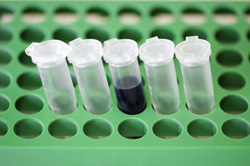Enhancing the study of genetically modified cells
The 'Combined isolation and stable non-viral transfection of hematopoietic cells - a novel platform technology for ex vivo hematopoietic stem cell gene therapy' (Magselectofection) project set out to develop a platform for non-viral integrated ex vivo cell separation and transfection. Development of the technology was based on an approved magnetic cell separation technique combined with magnetically enhanced transfection. The EU-funded project's vision was to accomplish this on nucleic acid constructs allowing for site-specific genomic integration into non-coding regions of the host genome. Project partners were successful in combining nanomagnetic cell separation with the genetic modification of cells, and stem cells in particular. Experimental results revealed that when carried out according to an optimised protocol, Magselectofection can produce a high yield of selected target cells, of which a high percentage is genetically modified, at high purity. More specifically, Magselectofection-engineered hematopoietic stem cells (HSCs) and mesenchymal stem cells (MSCs) retain their ability to differentiate into one of many cell types and therefore offer the opportunity to study multiple lineages. The project's platform technology involves few handling steps, is efficient and simple to execute and can be adjusted for automation. The first commercial products for use in research were launched in 2010, with plans to develop a product for clinical use according to demand. Knowledge about manufacturing suitable magnetic nanoparticles and how to combine magnetic cell separation and nucleic acid delivery is key for optimising the technology's potential. Partners intends to publish this knowledge, protected by patents or patent applications, and include it in application notes accompanying commercial kits. Magselectofection technology meets a billion euro market in regenerative medicine alone and, as an enabling technology, may be worth several hundred million euro over a product cycle. Project outcomes open the path to working around problems related to viral vectors, advancing health care and fostering the competitive advantage of the EU biotech industry.







